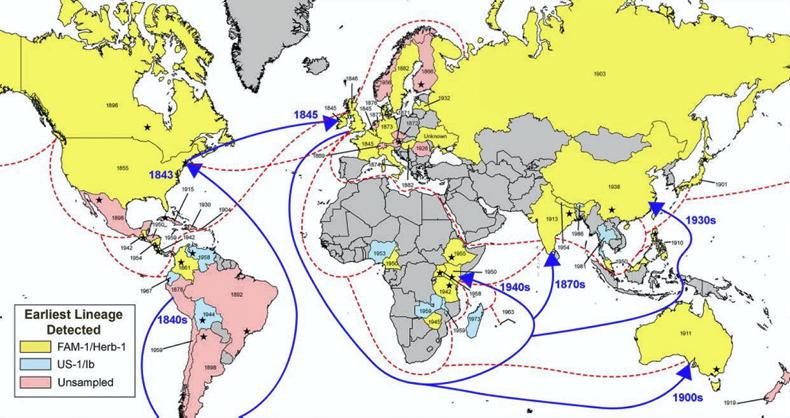The strain of late blight which decimated Irish potato crops and led to the Great Famine was much more widespread around the world than first thought.
A new paper published by researchers at North Carolina State University found that the specific strain of late blight, known as FAM-1, was present across six continents.
FAM-1 caused massive and debilitating late-blight disease outbreaks in Ireland and contributed to mass starvation and migration between 1845 and 1852.

Global map of early outbreaks of late blight caused by Phytophthora infestans. Years within each country indicate the date of the earliest known specimen, while colour indicates if the genotype was FAM-1, US-1 or unsampled. Dotted lines indicate representative trade routes of the British Empire circa 1932. Arrows indicate the most likely migration path taken by the FAM-1 lineage into Africa and Asia based on DIYABC analysis and trade routes. Stars within each country indicate the approximate location of the first recorded outbreak, if known.
Plant pathologists studied the genomes of about 140 pathogen samples – historic and modern – from 37 countries on six continents to track the evolution of different strains.
The results of the study show that the FAM-1 historic lineage was found in nearly three-quarters of the samples (73%) across six continents.
144 years
The earliest FAM-1 genotype was found in France in 1845 and the most recent was found in Malaysia in 1987.
This indicates that the famine lineage circulated around the world for more than 144 years before being replaced with other modern strains.
British spread
FAM-1 was the first genotype detected in almost all of the former British colonies from which samples were available, the report states.
The data from historic outbreak samples suggest the FAM-1 genotype spread to Asia and Africa from European sources, likely during global colonisation.
Author of the report Dr Jean Ristaino said: “FAM-1 was much more widespread than previously assumed, spreading from Europe to Asia and Africa along British colony trade routes.”
The strain of late blight which decimated Irish potato crops and led to the Great Famine was much more widespread around the world than first thought.
A new paper published by researchers at North Carolina State University found that the specific strain of late blight, known as FAM-1, was present across six continents.
FAM-1 caused massive and debilitating late-blight disease outbreaks in Ireland and contributed to mass starvation and migration between 1845 and 1852.

Global map of early outbreaks of late blight caused by Phytophthora infestans. Years within each country indicate the date of the earliest known specimen, while colour indicates if the genotype was FAM-1, US-1 or unsampled. Dotted lines indicate representative trade routes of the British Empire circa 1932. Arrows indicate the most likely migration path taken by the FAM-1 lineage into Africa and Asia based on DIYABC analysis and trade routes. Stars within each country indicate the approximate location of the first recorded outbreak, if known.
Plant pathologists studied the genomes of about 140 pathogen samples – historic and modern – from 37 countries on six continents to track the evolution of different strains.
The results of the study show that the FAM-1 historic lineage was found in nearly three-quarters of the samples (73%) across six continents.
144 years
The earliest FAM-1 genotype was found in France in 1845 and the most recent was found in Malaysia in 1987.
This indicates that the famine lineage circulated around the world for more than 144 years before being replaced with other modern strains.
British spread
FAM-1 was the first genotype detected in almost all of the former British colonies from which samples were available, the report states.
The data from historic outbreak samples suggest the FAM-1 genotype spread to Asia and Africa from European sources, likely during global colonisation.
Author of the report Dr Jean Ristaino said: “FAM-1 was much more widespread than previously assumed, spreading from Europe to Asia and Africa along British colony trade routes.”







 This is a subscriber-only article
This is a subscriber-only article











SHARING OPTIONS: